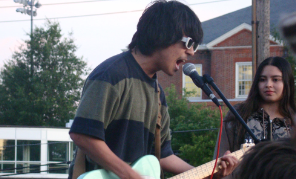Auditions. Callbacks. Crew meetings. Director meetings. Rehearsals. Choreographing. Sitzprobes. Tech Weekend. The infamous “Hell Week.” On the opening night of WJ S*T*A*G*E’s The Wiz, these albeit vital aspects of the preparation process for the spring musical were far from the minds of most audience members.
“When you watch a show, it’s only [around] three hours, and you don’t really realize that immense amounts of work, re-choreographing, learnings songs, etc., etc. [went into the show],” said senior Gina Amsellem, who was double cast as Addaperle. “You don’t realize how much work it really takes and how long we’ve actually spent doing it.”
Director Colleen McAdory says it took a multi-step process for the cast, crew, orchestra, and production staff – McAdory, tech director Kevin Daney, producer Jon Bos, and vocal director Isabel Hernandez-Cata – to make The Wiz as magical as possible. Once the production staff agreed on The Wiz as this year’s spring musical, they held three days of auditions to begin the four-month long process.
On the first day of auditions, students sang parts of songs from The Wiz of varying ranges. The second day of the pre-callback auditions was the dancing audition, which McAdory finds to be a crucial part of the selection process.
“That really helps us to solidify chorus,” said McAdory. “We ask [auditioners] when they sing to sell the song. We ask them when they dance to sell what they’re doing. And that tells us a little about their presence on stage and their acting ability.”
The directors had to make some difficult cuts for the final days of auditions, called callbacks, but the most difficult cuts came after that, when the production staff met at a restaurant to painstakingly decide on the call list.
“[Callbacks are] painful,” said McAdory. “It’s hard for me to think sometimes at night about some of the people who are going to be disappointed in not getting a principal role or getting cast at all.”
According to McAdory, approximately 30-40 students fit this description. On the flip side, McAdory and the team of directors also found some roles so difficult to cast that they resorted to double-casting. McAdory said that if she and the other directors felt two students were equally deserving for a specific part, the role was double cast and both students got the part.
When the grueling selection process was over, McAdory created a calendar of goals and itineraries and discussed these goals with the production staff and crew chiefs.
“I try to go piece by piece,” said McAdory. “If I were to look at the whole big picture every day, I would be very much overwhelmed.”
Once the planning got started, the cast began the first round of rehearsals which focused on practicing one scene at a time. During the first four-day bloc of scene-work, the cast would read through the script, work on the blocking with McAdory, learn any music and choreography in the scene, and practice everything together. These practices went from 2:30-4:30, and eventually lasted until 5:30 when the cast did their second round of rehearsals.
Early in the preparation process, technical director Ty Huber went on extended leave. The absence of this crucial member of the S*T*A*G*E community threw many crew members for a loop, and left them largely depending on their own set-making experience despite Daney’s accommodating help. Musical director Hernandez-Cata also went on a week-long leave due to medical complications. The following deaths of two indispensable members of the WJ community rocked the spirits of S*T*A*G*E members and students throughout the school.
Despite all of the complications and dampened morale, the cast and crew of The Wiz managed to put their all into Hell Week, and, ultimately, into the performance as a whole.
“It just felt like everything that could happen to us happened,” said McAdory. “I’m extremely proud of the fact that people stepped up and that we were able to put in the hours and pull together as well as we did.”
Once the cast was familiar with their scenes, they would go through an entire act. To prepare the cast members for the big performances, Hernandez-Cata taught them the music, which was largely based on a variety of African American styles, including boogie-woogie, gospel, and New Orleans. But her job was not limited to teaching music.
“I think that I have to teach them to bring the song to life, whether it’s [through] movement, how they speak or what they do with their face to make the song more effective,” she said.
Eventually, the pit orchestra began working with the cast. Every Tuesday and Thursday, the pit and cast would convene in the band room and go through each song in a practice called a ‘sitzprobe’. During these special practices, the cast members who had to sing would stand and do so as the pit played the music.
Sophomore pit member Isabel Carton recalls the first time they practiced with the ensemble; during the tornado scene, almost everybody in the pit stopped playing, stood up, and stared at the performance with glazed eyes.
“There were only, like, two people playing,” said Carton, laughing.
Once the cast and pit orchestra had become familiar with each other, the tech began incorporating what they had been working on along with the cast and orchestra. During the weekend before the show, called Tech Weekend, the tech crew put the fruits of their labor into each scene. On the Saturday of Tech Weekend, the orchestra and cast set up in the cafeteria and did a full run-through while Ms. McAdory worked with the technical crew in the auditorium.
There was a lot of stopping and starting to perfect lights, sounds, and other technical affects. According to McAdory, during Tech Weekend they do something called a ‘cue to cue’, which is basically practicing the performance from one technical cue to the next.
“It can sometimes get tedious. Your patience grows very, very thin,” said McAdory.
According to sophomore light designer Alexine Buchanan, crew has to preset the stage before each act. As a light designer, she does a fixture check on all of her light fixtures, goes through her cue to make sure everything is working correctly, and turns everything on.
Nearly four months after the first stage of preparation had begun, and it was time for Production Week – or, as it has been more aptly nicknamed, “Hell Week.” Beginning on the Monday before the show, Hell Week required five days of tireless work and dedication, and was S*T*A*G*E members’ only chance to make the final finishing touches to their production.
“I was tough on them,” said Hernandez-Cata. “I was merciless. I think half of the cast probably hates me by now. I’m really okay with it, because I’m happy with how the show has gone so far, and I’m confident that this weekend will be even better.”
Among other features of “Hell Week,” last-second rehearsals and practices, short breaks and 15-hour days are all to be expected, according to sophomore Sarah Collins. Pit orchestra, cast, crew, and directors were required to stay after school until 8-10pm every night, and were cut very little slack by most teachers.
According to Collins, it’s during Hell Week that everyone “cracks down” and “starts to put everything into [their] work.” She adds that without it, they wouldn’t be close to ready for the final performances.
Cuadra went so far as to say, “No one learned their stuff until Hell Week.”
But despite the months of dedication and hard work required to execute the show, many cast and crew members wouldn’t trade the experience for the world.
“We’re there because we love to perform,” said junior Mariel Berlin-Fischler, who is an ensemble member, encore crew chief and publicity co-crew chief. “And though we work very long and have insane hours, at least for me, the moment we hit the stage, it’s all worth it. I think this is a show that WJ will be very proud of, and I am honored to be a part of the cast and crew.”







